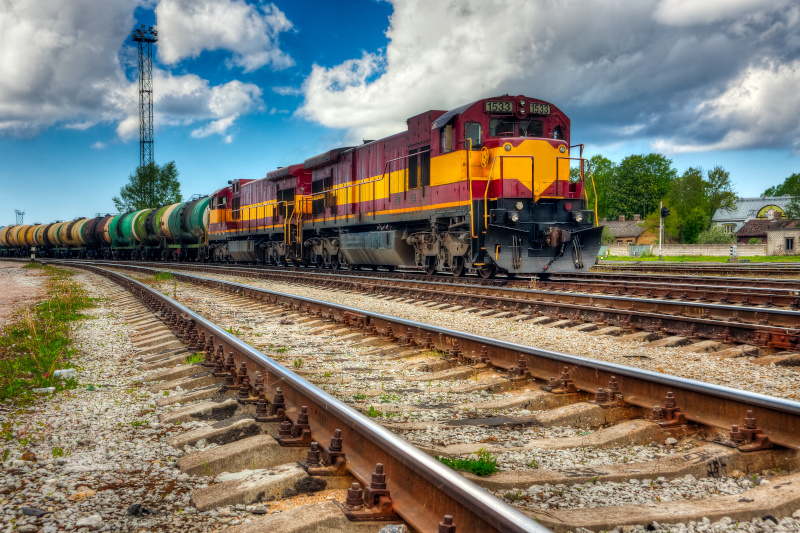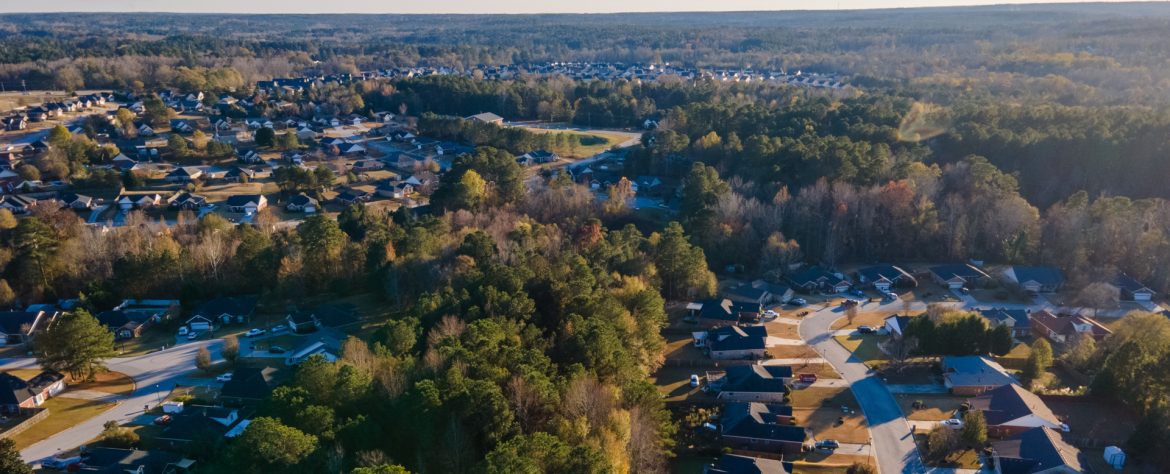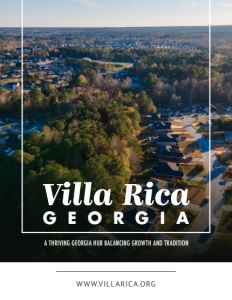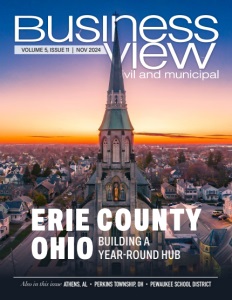Villa Rica, Georgia
A Thriving Georgia Hub Balancing Growth and Tradition
A civic focus on revitalizing downtown, expanding housing, and creating local job opportunities
Villa Rica, Georgia, seamlessly intertwines small-town charm with steady growth. Situated 35 miles west of Atlanta, this historic town was once known for its gold rush history and agricultural roots. Today, Villa Rica finds itself at the crossroads of balancing its rich past with the demands of a rapidly growing population. Like many across the country, the city faces challenges in the wake of the pandemic. Yet, it continues to attract new residents and businesses, making it a notable contender in the ever-evolving metro Atlanta region.
As Mayor Leslie McPherson explains, the effects of the pandemic have left a lasting mark on the city’s business landscape. “We’ve suffered to a degree with inflation and are still dealing with the hangover from Covid,” she notes candidly. Like so many nationwide, local businesses have felt the strain. The mayor acknowledges that while Villa Rica is recovering, other cities have bounced back more swiftly. The city has seen a slower rebound, but it’s not without its successes.
Despite these economic hurdles, residential construction is one area of marked growth in Villa Rica. Mayor McPherson describes the surge in housing development, ranging from single-family homes to townhouses and apartments. “We’ve added hundreds of additional residences,” she says, pointing out that this growth is in response to the nationwide housing shortage. The city has seen a boom in both homeownership and rental properties, particularly townhomes—something Villa Rica had previously lacked.
However, the mayor is clear that this rapid expansion has its limits. The city has temporarily paused multifamily housing projects with a six-month moratorium to assess their impact on local infrastructure. “The density of multifamily housing means you’re putting a lot more people into a small area,” she explains, indicating the strain on resources like roads, water, and sewer systems. While Villa Rica produces a significant amount of its water, it also relies on neighboring counties for additional supply. Managing this balance is critical, and Mayor McPherson emphasizes the need for a sustainable approach to growth.

A Strategic Location and Lifestyle Appeal
Villa Rica’s geographical position between two major southern cities—Atlanta and Birmingham—plays a significant role in shaping the city’s appeal. This prime location offers residents easy access to urban amenities while allowing them to live in a quieter, more affordable setting.
“When you consider where we’re located, just off of I-20 between Atlanta and Birmingham, we have access to so many things,” Mayor McPherson notes. She points out that although Villa Rica may not have the same level of dining and entertainment options as its larger neighbors, nearby Carrollton offers a growing array of restaurants and attractions. Plus, the short commute to Atlanta—just 30 to 45 minutes, depending on traffic—means that residents can easily access top-tier medical facilities, cultural events, and the airport without being entrenched in the hustle and bustle of city life.
“We’re also probably a 20-minute drive from the Silver Comet Trail,” Mayor McPherson adds. The trail, popular with cyclists and hikers, stretches from the edge of Atlanta into Alabama, offering locals an opportunity to enjoy the outdoors, whether biking long distances or simply taking a leisurely walk. For water enthusiasts, kayaking is available just a short drive from Tallapoosa. “Everything is not right here in the city, but where we’re oriented with everything around us is a big advantage for residents,” the mayor says, describing how the surrounding resources make Villa Rica a compelling place to live.
In addition to its geographic appeal, Villa Rica has cultivated a reputation for its vibrant local events. One of the most anticipated gatherings is the city’s annual July 3rd celebration. “People come from all over to our July 3rd event,” Mayor McPherson says. The daylong festival features more than just fireworks—bouncy houses, live bands, and local vendors transform the event into a family-friendly experience. “It’s a late afternoon into the late-night event,” she adds, highlighting the sense of community that Villa Rica continues to engender through these celebrations.
Revitalizing Downtown and Expanding Industrial Space
Villa Rica continues to grow, and attention is increasingly shifting to revitalizing its historic downtown and expanding industrial opportunities. The Interim City Manager, Jeff Reese, shares that the city is working on plans to enhance downtown walkability.
“We just met with a group on some funding opportunities,” he says. Villa Rica is exploring architectural designs to create more pedestrian-friendly pathways and public spaces. One of the more ambitious ideas includes reviving the Gold Nugget Trail, a project initially aimed to connect downtown through a network of trails similar to Carrollton’s Greenbelt system. “As new developments come in, the trail would be expanded through that development,” Reese explains, pointing to a broader vision of integrating green space into Villa Rica’s ongoing growth.
For Mayor McPherson, the character of Villa Rica’s downtown is shaped by its independent, locally owned businesses—a focus the city is working hard to preserve. “You can go to any city and find a big chain store,” she remarks, but what makes Villa Rica unique are the small, family-run businesses that line its historic streets.
Even so, one challenge Villa Rica faces downtown is vacancy. While facade grants are already in place to help restore storefronts, more work must be done to fill these empty spaces. “We have more vacancies than before Covid,” Mayor McPherson admits. The city is on track to remedy this but recognizes that the road to recovery for small businesses is far from easy. Local residents play a critical role in this resurgence. “They do need residents believing and shopping local,” she emphasizes, reiterating the importance of community support in sustaining Villa Rica’s unique downtown identity.
Outside of the downtown core, Villa Rica is nearing full capacity in its existing industrial park, signaling a need for future expansion. “Unless we buy more property, what we currently have for industrial is full,” Mayor McPherson says. There is little space left, with only one potential vacancy, and the city is actively searching for new locations to support industrial growth. Carroll Tomorrow, an economic development arm of the local Chamber of Commerce, has also started shifting focus from primarily industrial to include commercial development, particularly in areas like downtown where businesses are struggling to bounce back post-pandemic.

Infrastructure and Connectivity
As Villa Rica looks to accommodate its expanding population and increasing commercial interest, infrastructure, and road improvements have become critical focal points for its leadership. Reese is optimistic about the future, particularly regarding industrial growth.
“Development is finding us, which is a good thing,” he says, referring to industrial clients’ recent uptick in interest. Villa Rica’s location along I-20—situated between Birmingham and Atlanta—has proven to be one of its strongest assets, and the upcoming north bypass will provide even more industrial space.
While commercial and industrial development is advancing, maintaining and improving critical infrastructure is equally essential. Regarding internet access, Villa Rica is in a relatively strong position compared to more rural parts of Carroll County. “We’re not as rural as some areas that have struggled,” Mayor McPherson points out. However, traffic remains a significant concern, especially with Villa Rica being a hub for local and commuter traffic. Reese elaborates, “State highways and an interstate crisscross us, and that brings with it a problem.”
The city recently conducted a comprehensive traffic study, confirming what many locals already knew: many of the cars clogging Villa Rica’s streets are outside the city. “A lot of folks that come through to Villa Rica don’t live here,” Reese notes, explaining that commuters use the city as a pass-through to get to their homes further west or north. This heavy traffic flow presents complications, particularly with the influx of 18-wheelers adding to the congestion. “We can do all the moratoriums we want on buildings here,” he adds, “but that doesn’t solve the issue of non-residents passing through.”
The anticipated north bypass will help address this by rerouting heavy trucks from downtown. Mayor McPherson echoes the significance of this project, emphasizing how it will relieve the city’s main arteries. “That will remove those big semi-trucks that come through the middle of our downtown,” she says. This development, combined with other road projects, will enhance Villa Rica’s connectivity and alleviate pressure on the city’s current roadways, many overburdened. Reese explains, “Everybody basically empties on the same three or four roads, which all end up on I-20.” This lack of connectivity forces a bottleneck, and the city is actively working with the state to widen roads and create more routes for local traffic.
In addition to the bypass, Villa Rica is investing in smaller road projects that will offer residents more options for getting around. Mayor McPherson highlights ongoing developments, including a new road connection that will help link different parts of the city without relying on state highways. “I drove by where a major clearing is going on; that’s going to provide a nice connection in the middle of the city,” she says. These small but significant improvements will reduce the need for residents to pour out onto the city’s main thoroughfares, easing congestion. Although smaller in scale, these efforts are part of a larger plan to improve connectivity throughout Villa Rica. “I’ve been in those cities where you get off the highways, and they’ve got a long corridor like Dallas does,” McPherson says, adding that while Villa Rica doesn’t yet have that level of infrastructure, the city is working toward a version that suits its size and needs.
Looking Ahead: A Focus on Housing, Workforce, and Commercial Development
In Villa Rica, the next 18 months will see efforts to ensure the city doesn’t just grow in size but also opportunity. Reese is particularly proud of the city’s efforts to diversify housing options. “We have multifamily dwellings that are in the process. We have workforce housing. We have senior communities that are planned,” he says. Unlike some communities that focus on catering to one segment, Villa Rica is intentional about its inclusivity. “We’re not trying to just be a community of millennials or any particular generation,” he explains.
For Mayor McPherson, housing remains a top priority, but the ultimate goal is to reduce the number of residents commuting long distances for work. “We don’t want all those people to leave, as a vast majority of our population does, and drive to Atlanta for work,” she says. To tackle this, the city focuses heavily on developing its commercial sector, aiming to create more local job opportunities to keep residents working closer to home.
The mayor is especially passionate about revitalizing Villa Rica’s historic downtown. “Revitalizing our historic downtown is probably top of the list,” she emphasizes. While the city’s basic infrastructure and recreation services are always a priority, the mayor is personally committed to breathing new life into the downtown area. She believes that enhancing downtown will draw more visitors and encourage local businesses to thrive. However, commercial development isn’t just limited to downtown; the city is also working on bringing in businesses outside the core, aiming to give residents more local shopping options and employment options.
In the months ahead, Villa Rica’s leadership is on a course toward thoughtful, inclusive growth. By addressing the city’s housing needs, building stronger commercial opportunities, and reinforcing the collaboration between government and local institutions, the city is positioning itself for a future where current and new residents can live, work, and thrive without looking outside their community for opportunity.
AT A GLANCE
Villa Rica
What: A growing city focused on downtown revitalization, housing, and commercial development
Where: Georgia, USA
Website: https://www.villarica.org/
PREFERRED VENDORS
Tanner Health – www.tanner.org
Tanner Medical Center/Villa Rica is an acute care hospital offering maternity care, inpatient care, intensive care, interventional cardiac services with angioplasty and stenting, advanced diagnostic imaging services, a new emergency department and surgical services center, as well as a host of other services. See more at tanner.org.
E.R. Snell Contractors, Inc. – www.ersnell.com
E.R. Snell Contractors, Inc., headquartered in Snellville, Georgia, has been a trusted construction leader since 1923. Initially founded to meet the demands of automobile travel, we specialize in building essential infrastructure. Our mission emphasizes integrity, honesty, and fiscal responsibility, guided by core values that prioritize family and collaboration.
Fuqua Development – www.fuquadevelopment.com
Fuqua Development LP was established in March 2012 by Jeff Fuqua, Principal, and Heather Correa, Partner. Fuqua Development has successfully completed many notable projects such as The Braves Battery Atlanta at Truist Park, and has multiple mixed-use projects under construction or in development throughout metro Atlanta. Fuqua is synonymous with bold, innovative, cutting-edge, mixed-use developments in urban and suburban settings.







